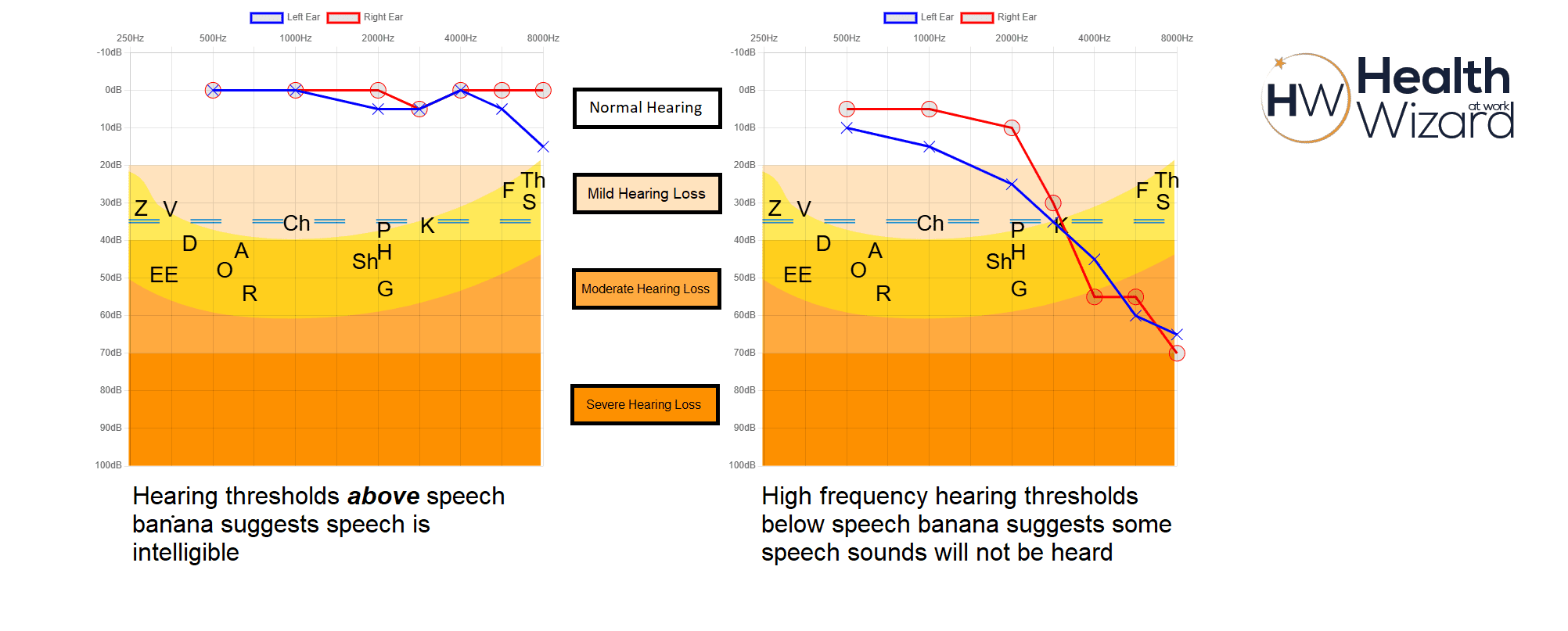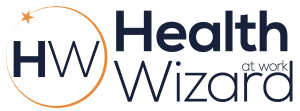Health Wizard at Work’s hearing test service is primarily used for HSE hearing surveillance (the calibrated hearing test system is also suitable as a wellness service to staff). Every hearing test we do includes a full hearing threshold audiogram featuring the “speech banana”. Strictly speaking, the HSE does not look for this information, but we think it is hugely valuable and important to employees and their employers.
So why does Health Wizard at Work put the speech banana on every Hearing Wizard audiogram?
What is the speech banana?
By plotting the pitch and volume of individual sound components of speech, the consonant and vowel sounds (phonemes) in speech can be marked up onto an audiogram. Back in the dark ages, some bright spark noticed how the arrangement of these phonemes formed a comforting smiley shape on the audiogram. And they got out their yellow crayons. Hey presto, one speech banana, which – when combined with your audiogram – shows where your hearing ability coincides with the typical sounds in speech.
If the speech banana is further down the page than the red or blue lines representing your hearing thresholds, you’re likely to hear sounds in that portion of the banana. If your thresholds are are under the banana, you’re going to struggle.
While not required by the HSE for hearing surveillance, the speech banana is a useful, visual tool that is widely used by audiologists and hearing healthcare professionals. This also makes it useful in occupational health, although few providers use it.
How important is the speech banana?
First off: everyone has a different accent, speech volume or tonal inflections so it is important to note that the speech banana is an approximation. So while it is not appropriate to go crazy on the detail, dropping the banana onto an audiogram does indicate how your hearing levels may impact your ability to hear speech – which is generally acknowledged to be one of the primary functions of both speech and hearing.
In short, the speech banana is an illustrative device and is certainly not a diagnostic tool. It is particularly good at showing that high-frequency sounds like “s” and “th” can be harder to hear, especially with age-related hearing loss, which commonly affects higher frequencies. This makes the speech banana a very important tool in explaining hearing loss and the possible implications of problem hearing or damage due to Noise Induced Hearing Loss.
 Vowels vs. Consonants
Vowels vs. Consonants
Vowel sounds are generally low-pitched and relatively loud. Meanwhile, consonants are generally higher-pitched and are good at providing definition to a word – consider the importance of the “s” in “cabbages” – the plural is an important distinction between 1 and many. Likewise, a sentence tends to lose a lot of meaning without the high pitched “th” sounds. And so on.
Speech Banana: Try it for Yourself
Comparing the intensity of high and low speech sounds provides a useful example of the relative values of high and low pitch sounds. Try saying “sssss” like a snake as loud as possible, and compare this high-pitch sound to the top volume you can obtain with your best pirate “oo-arrr”, which is a very vowel-heavy sound. The relative volumes of these 2 sounds translate into intelligibility: high frequency sounds are not as loud or robust as low vowels, which makes them less intelligible and easier to mis-hear.
The impact of this is profound:
without the ability to hear high-frequency sounds, ‘three sharp scissors’ could come across as ‘ree arp i-ors,’ which is hugely difficult to understand. On the other hand, a phrase like ‘Kate made a cake’ without low vowel sounds might sound like ‘K-t m-d – c-k,’. This is difficult, but the meaning is still fairly clear, unlike in the first example.
So not only are high pitched phonemes some of the quieter sounds in speech, they are also disproportionately important for comprehension and extracting meaning. A degraded ability to hear these sounds therefore presents a double whammy.
The Speech Banana – Supporting Health & Safety
Unfortunately, the most common form of hearing loss takes place in the high frequencies. This could be due to noise induced hearing loss (NIHL) or old age, among other things.
The speech banana therefore helps patients and employers understand the real-world impact of a (potential) hearing loss on speech comprehension and safety. This could include the effects of hearing on training, sharing important instructions or even situational awareness: electric vehicles typically emit a quiet sound – comparable to the phonemes discussed above – which introduces a significant new risk to any office car park.
By contrast, traditional Occupational Hearing tests and hearing surveillance often do without the speech banana (or even an audiogram) and just quote a “hearing category”, based on a comparison of your hearing against what is “normal” for your age and sex. The result of this is that as we get older – with correspondingly looser criteria for “normal hearing” – it is possible for someone with category 1 hearing, to have hearing that would be considered poor from a medical perspective.
This is a problem, because in the absence of other information or guidance, like the speech banana, “category 1 hearing” risks being interpreted as being “good”.
You read that right: medically speaking – Category 1 hearing can have a hearing loss if you’re in your middle age, or older.
Hearing categorisation is a valuable reporting tool for the HSE, but is thus an unsatisfactory measure of hearing ability. Health Wizard at Work therefore includes a full audiogram INCLUDING the speech banana in every Hearing Wizard hearing test to ensure individuals and employers understand the practical implications of their hearing ability, beyond the categorisation required by the HSE.
We think that the speech banana, gives a much better ability to understand the risks and challenges faced by an individual as a result of their hearing: Would they be able to hear essential training? Is the car park a higher risk for them? And So on.
More than Just Hearing Surveillance
This of course also means that the Hearing Wizard hearing test is suitable for both HSE surveillance and also “wellness” hearing monitoring – where the HSE category is less relevant than the other information in our report assessing your hearing.
And that is why Health Wizard at Work includes the speech banana on every Hearing Wizard hearing test report.



